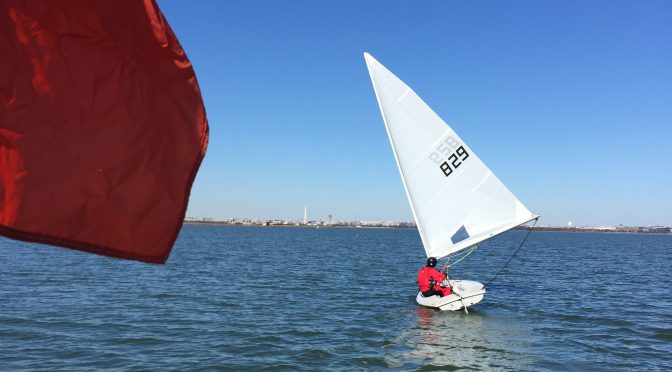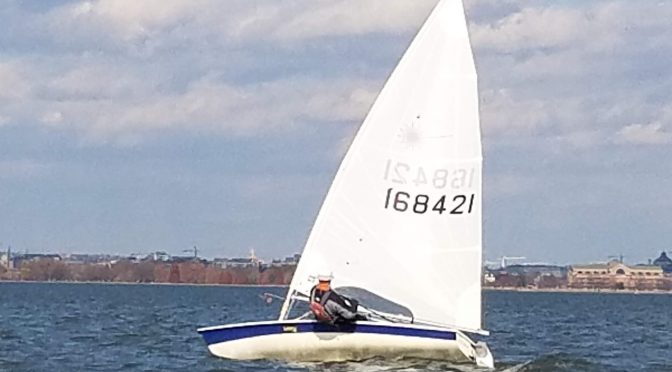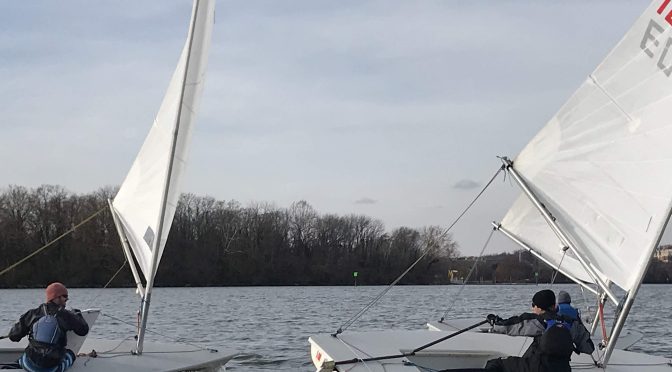Tag Archives: Laser Class
2019-2020 Laser Frostbite Series #12
The forecast and the actual weather didn’t line up at all which makes me leery. The weather called for light winds from the west switching to stronger from the south. When I got to the marina winds were light and shifty but coming from the north by the time we got on the water. The first two races were in the light and shifty stuff with a very strong down river current. RC wisely got the races off without worrying about a perfect course. For the first races I was focused on managing current rather than wind and this seemed to help some. I would head offset to the mark to counteract the current. In the very light wind, when it’s too light for tell-tails and wind vanes, I use a wet finger to determine where the wind is coming from. Then I setup the sail so it looks correct relative to where I think the wind is coming from. I steer to try to make sure I’m not pinching, as speed takes a while to build and there isn’t enough wind to show pinching in the sail. After the second race the wind died completely and it looked like wind would fill from the south. As the wind came in RC did a quick course reset and we got in 3 more races with a nice breeze. The current was still strong and was now pushing boats over the line. I was OCS in the last two races, and I managed to force Nich with me in the last race. Factoring in the current would have helped me here. In the medium breeze I’m keeping the boat very flat and looking for clear air on the favored tack. I focus on pointing and keeping my speed up. I did manage to factor in current for the windward mark layline and picked up a few boats the overstood. Overall it was a nice and sunny day, great to be out on the water. We also had Richie come out for the first time so welcome to him. Thanks again to John and Mike for doing RC!
2019-2020 Laser Frostbite Series #11
2 racing.
The forecast (Windfinder) for this past Sunday (2/2) was for 8-9 mph winds from the W or SW with gusts
into the high teens. It was also supposed to be sunny, which turned out to be true. All things considered, a
great forecast. But right after the Skippers’ meeting, the direction of the wind changed substantially. In
fact, once out on the river, the wind was from the South. This necessitated a change of plan with respect
to setting the course. Actually, it was easier now because of the much larger playground available. After
setting the pin end of the starting line, the windward mark was dropped near the (former) power plant and
then the leeward mark up-river, near the airport. To lessen the chance of mayhem at the windward mark,
we set the starting line so that the first upwind leg of our W/L course would be as long as was reasonable.
The group had agreed at the Skippers’ meeting that there was no need for a reaching mark because of the
light wind prediction.
The RC was ready at 12:35, but our wonderful Ollie timer had decided to stay home; instead, Jim
provided us with a decidedly low-tech whistle for the count-down. To see how long it would take to sail
the course, the RC decided on a ‘once around’ for the first race. A sigh of relief from the RC boat once the
fleet got going without anyone being OCS (‘over early’). It took about 15 minutes for the winner (Nich) to
finish, and the others followed in the next five minutes or so. Therefore, we stuck with that format for the
next three races. Sometime after (or during; not sure) the third race, the wind increased significantly. We
had no wind meter, but the report from National Airport indicated 12 mph around 2 PM and 16 mph an
hour later. And yes, we did see small white caps. Because of this development, we decided (with gentle
encouragement from Farley) to do a ‘twice around’ for the fifth race. Once the fleet got going, several
sailors got themselves into ‘unusual’ situations. Fortunately, most everyone was able to self-rescue, but we
must give a shout out and much credit to two (Michael L and ?) who helped getting the Georgetown #3
Laser back on its feet near the windward mark. To make it more interesting, the RC also had to keep its
eyes on Mike S who had trouble as well getting his boat right side up. We could see that his boom (which
had gotten loose), and likely also his mast, had gotten stuck in the shallow area not too far from the RC
boat. With no ready resolution in sight, we decided to pick him up and let his Laser sit, to be rescued
later. After lifting anchor and turning on the engine, our (recently serviced) 17′ skiff behaved admirably.
Mike was hoisted aboard, but was, fortunately, in no distress. By the time we got back to our proper
position on the line, the fifth race was still ongoing. Tom finished first, way ahead of the others, but credit
should be given to the lighter weight sailors in the breeze. By now, several of the fourteen boats that had
raced today had gone back to the marina, and we decided to call it a day.
Later on, a small group went out again with our fleet captain to retrieve Mike’s Laser and the marks. The
rig was put on the skiff and the hull towed back to the marina without further issues.
We hope that everyone had a good time at least some of the time; it was quite a day for the RC (Greg &
Jacob)!
2019-2020 Laser Frostbite Series #10
|
2019-2020 Laser Frostbite Series #8
Third Place Write-Up, 2020 Frostbite #8 – 1/12/2020
Weather:
This Sunday we lucked out with wind. There was a storm Saturday that passed perfectly. We were catching the tail end so that there was good breeze that later Sunday dropped to very little wind. The weather reports indicated strong wind, but on the day it was less that predicted. Turnout was good with some new fast sailors making an appearance.
Starts:
I had some good starts and some not so good starts. The wind was a bit up and down as well as shifty. My bad starts I though I was in good position in the middle of the line, then a shift put me unable to fetch the pin end. Another time a swirl put me in irons pre-start, very not-good as boats going backward have no rights. Fortunately the boats around me all pass me without incident so, through no skill of my own, I didn’t foul anyone.
Swirl upwind:
Upwind there were some small and big shifts. Sometimes I got these right and passed boats, sometime I got this wrong and lost boats. I’m getting better at steering, telling when I’m getting headed vs when I’m just pinching. A lesson I need to learn better is when the wind is this shifty to try to stay in the middle of the course to not get buried by a big shift. The oddest thing going up wind was when closer to the mark it seems there were swirls, possibly from jets or from puffs dropping to the water. A swirl would seem to have wind but it would not be from any specific direction. One race I thought I was tacking on a header but in reality was not. The tack didn’t help and I’d given up all my speed to the swirl. Other times boats ahead of me would get caught in them, dramatically slowing down, like I had. The swirls were very localized so getting hit by one seemed to be luck.
Downwind:
We had windward-leeward courses set so downwind was more or less strait down wind. I had more success staying on starboard rather than jibing. There were puffs that could sometimes be taken advantage of as well as a cross current that meant going inside was beneficial. I aimed for puffs more than trying to fight for a tactical position. This worked out okay, and I managed to avoid a couple of big pinwheels. Big thank you to RC for coming out and setting a course in the messy wind.
2019-2020 Laser Frostbite Series #7
2019-2020 Laser Frostbite Series #6
While the prediction was for no wind, we had a nice steady southerly all day. It might have gusted up to 8, but never went really light. Also not very shifty. I think I managed to get on the wrong side of whatever shifts there were however.
Hangover Regatta, New Year’s Day 2020
It was a beautiful sunny day with temperatures in the 40s and winds in the 10 to 18 mph range. Unfortunately, the wind was from the west which limits the length of the windward leg. So the race committee created a new rectangle (parallelogram) course with windward, reach, downwind, and reach legs in the hope of giving the sailors some planning opportunities. The races were quite long by frostbite Laser standards but the race committee got in 4 twice around races and 1 once around. The winds were puffy enough that there were quite a few capsizes.
19 sailors came out including Dave and Randy from the Marsh Creek Club in central PA and the Jacob family of James, Alex, and Erin.
The RC was Nabeel Alsalam, Jim Klein, Dan Miller, and Jacob Donkersloot.



